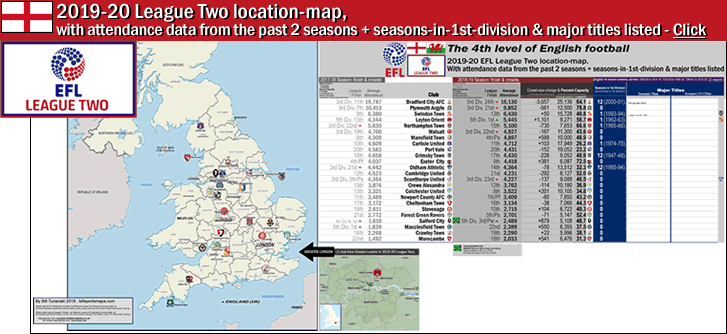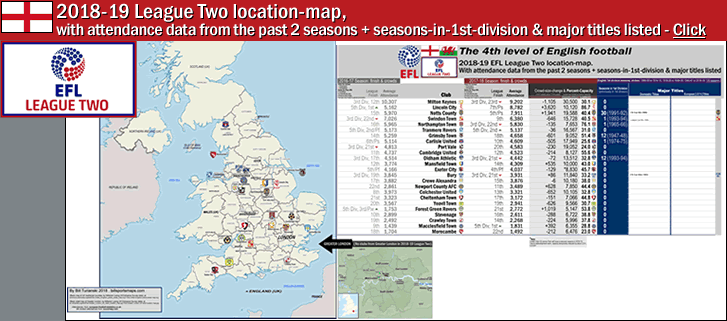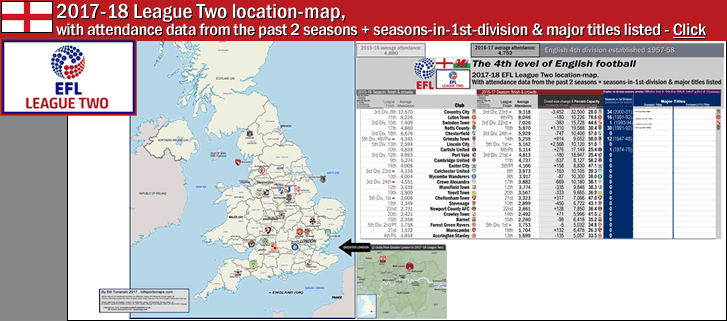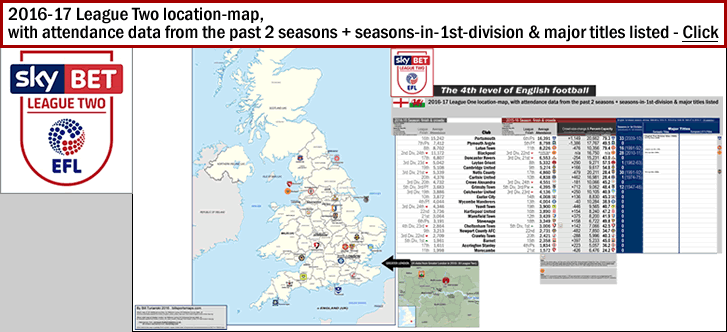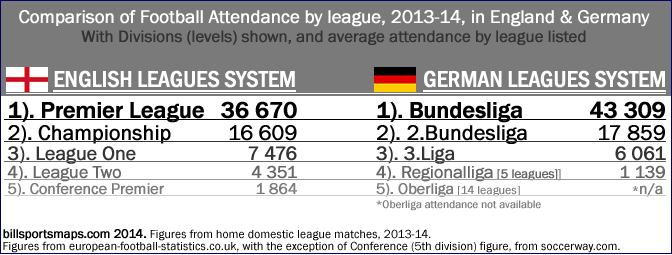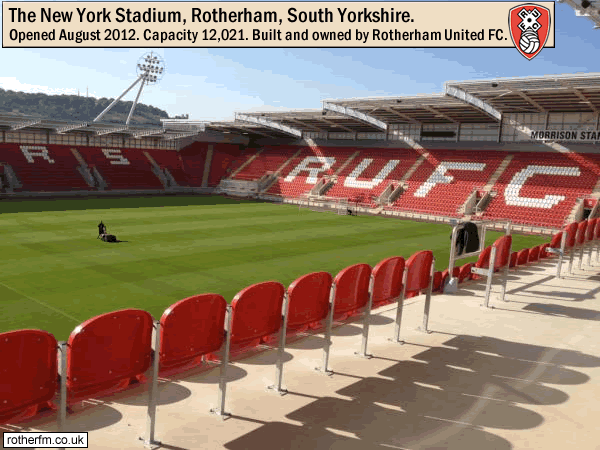
England, 4th division: Football League Two – 2013-14 Location-map, with attendance data & 2013-14 home kit badges
…
…
Note: to see my most recent post on the English 4th division, click on the following: category: Eng-4th Level/League 2.
…
On the map page
Facsimiles of each clubs’ home jersey badges for the 2013-14 season are shown, in alphabetical order, across the the top of the map page. Below that, at the lower left, is a location-map of the clubs in the 2013-14 Football League Two. At the right-hand side of the map page is attendance data for current League Two clubs from the two previous seasons (2011-12 and 2012-13). Change (by percent), as well as percent capacity (ie, how much the club filled their stadium on average), from last season, are shown. League movement (if any) of the clubs is shown as well.
The 2013-14 League Two
The 2013-14 League Two has been a very tightly-contested affair, with just over one-third of the season having been played so far (16 games played out of 46, for most clubs). To give you but one example of how evenly-matched the clubs in the fourth division are currently – and not just the clubs in the top half of the table – last week’s league leaders Fleetwood Town lost away to last-place Northampton Town 1-0 on Saturday 16th November 2013 (with a goal by the Cobblers in the 93rd minute)…and Fleetwood dropped clear out of the three automatic promotion places into 4th place with the loss, as Oxford United, Chesterfield, and Rochdale all won.
So currently, Oxford United, Chesterfield, and Rochdale all have 29 points and are separated at the top of the table by goal difference. Clubs like Portsmouth and Cheltenham Town, who are currently in 16th and 17th places on 20 points, find themselves in a simultaneous promotion campaign/relegation battle, both being at present 6 points above the relegation zone and 6 points below the play-off places. I wouldn’t say anyone could win promotion this season in the fourth tier, but there are certainly more than a dozen sides with a good chance of being one of the 4 clubs to gain promotion, and there are probably more than 16 sides that could feasibly win promotion.
Below are brief illustrated profiles of the top four clubs in League Two as of 17th Nov. 2013, with: a brief write-up of each club’s manager and 2 featured players; a photo and caption for each club’s manager; a photo for each club’s current top scoring threats; a photo or two of each club’s ground; plus each club’s league history (with Non-League history noted), as well as a look at each club’s home league average attendance from the last two seasons, plus current average attendance listed (current home league average attendance to 17 Nov. 2013 {via soccerway.com, here}).
…
Below, the top 4 in League Two after one-third of the 2013-14 season…
Oxford United FC, currently 1st place (29 points/+12 goal difference).
46-year-old Sheffield-born Chris Wilder, manager of Oxford United since December 2008 (back when they were in the middle of their 3 season spell in Non-League football), has been managing for over a decade now, having got his managerial start with the then-9th-Level (now Conference club) Alfreton Town, back in 2001-02, when Alfreton were in the Northern Counties East Football League, and the then-35-year-old Wilder got them promoted into the Northern League. Wilder then managed then-Conference side Halifax Town for 6 seasons (2002 to 2008), up until Halifax went broke and were liquidated (the Phoenix-club FC Halifax Town is now back in the Conference as of 2013-14). Wilder then worked as Alan Knill’s assistant at Bury in the first part of 2008-09 before getting the job at Oxford. Flash forward 3 years and 11 months later, and Chris Wilder is currently the third longest-serving manager in the Football League {see this, List of English Football League managers‘ (en.wikipedia.org)}. In Wilder’s first full season at the helm at Oxford (in 2009-10), the U’s won promotion via the play-offs (beating York City in the final at Wembley). Since then, Oxford United have finished in 12th, then in 9th, and then in 9th again last season (2012-13).
Throughout last season there were calls for Wilder’s dismissal by some supporters, and Wilder knows that probably only promotion will keep him at Oxford past this campaign. With a population of around 150,000 {2011 estimate}, Oxford is basically too big a city to only be hosting a fourth division side. Oxford United draw around 6K to 7K and in the past have gotten up to 10.3K (in 1986-7). Oxford fans would feel at the very least that their club should be in the third tier, and there are probably many gold-and-blue fans who dream of their club one day returning to the top flight – where Oxford United played for 3 seasons in the 1980s (86/87, 87/88, 88/89), when they were owned by Mephistophelian media baron Robert Maxwell, and when the U’s won their only major title, the 1986 League Cup.
Oxford United currently feature a striker who has had a longer spell there than Wilder – the Wiltshire-born 29-year-old James Constable, a classic lower-divisions bruiser of a forward, who has shaken off recent injuries and has scored 5 league goals this season so far. Overall, Constable has scored 85 league goals for Oxford in 216 games going back to the start of 2008-09, when he joined the then-Conference side on loan from Shrewsbury Town (Constable signed for Oxford 10 months later in the summer of 2009). Oxford fans will always love Constable for turning down the chance to almost double his wages – if he had went over to Oxford United’s much-hated nearby rivals Swindon Town. Here is what it says about that at James Constable’s page at Wikipedia…’Oxford accepted an improved offer for Constable from local rivals Swindon on 19 January 2012. Oxford allowed Constable to talk to the club, although he refused the opportunity to discuss the move with Swindon manager Paolo Di Canio.’…{end of excerpt}.
Just last week, Constable became only the third Oxford United player to have scored 100 goals in all competitions for the club {see this, ‘Constable’s century joy‘ (oxfordmail.co.uk, from 18 Nov.2013, by David Pritchard)}.
An up-and-coming striker also features in Oxford’s current set-up, the 25-year-old Deane Smalley, who signed for Oxford originally in the summer of 2011, but suffered an injury-plagued 2012, then re-signed with Oxford on less terms following a goal-less loan out to Bradford City. Smalley scored 5 goals in 2012-13 for Oxford (such as the one he is seen celebrating below), and has scored 5 league goals this season so far.
Perhaps the biggest impediment to Oxford United’s progression is their stadium situation – they don’t own the Kassam Stadium, nor does the Oxford City Council. It is owned by a shell company of the former club owner Firoz Kassam, and as such is an ongoing thorn in the side of Oxford United (since 2005-06). A sizable chunk of revenue Oxford United makes on ticket sales gets lost because of rent charges. To make matters worse, for the second season now, Oxford United must endure a stadium share with the second division Rugby Union club London Welsh RFC. So the pitch gets torn up, Oxford are more susceptible to injuries, and any attempts at an on-the-turf-passing-style get bogged down (literally) by mid-season.
In the spring of this year, supporters fought back this way…’Oxford fans successfully safeguard their stadium‘ (wsc.co.uk from 14 May 2013). In October 2013, this happened, ‘Kassam Stadium owners fail with appeal against community asset‘ (bbc.co.uk/sport/football).
Here is a recent article by Matthew Derbyshire from the Two Unfortunates site, about Oxford United’s stadium plight, ‘THE COMMUNITY VALUE OF FOOTBALL: OXFORD UNITED’S STADIUM BATTLE‘ (thetwounfortunates.com).
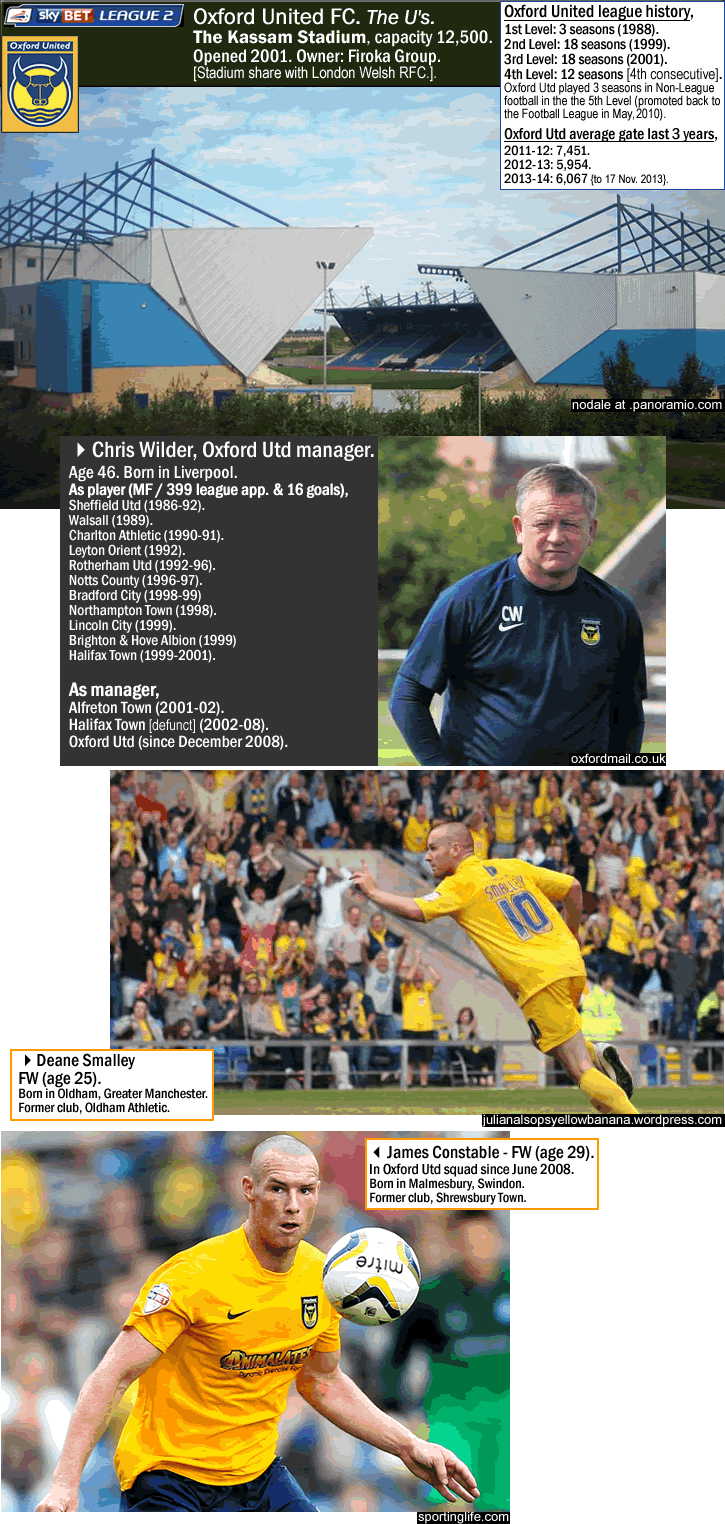
Photo and Image credits above -
Exterior-view photo of the Kassam Stadium by nodale at panoramio.com ; photos by nodale at panoramio.com.
Chris Wilder, photo from oxfordmail.co.uk.
Deane Smalley, photo from julianalsopsyellowbanana.wordpress.com.
James Constable, photo from sportinglife.com.
…
Chesterfield FC, currently 2nd place (29 points/+9 goal difference).
Liverpool-born Chesterfield manager and Football League veteran MF Paul Cook had to wait a while for his second shot at managing an English pro club. Cook had a rough go of it in 2006-07 as manager of Merseyside 5th-division club Southport, this right at the time when the former Football League club had decided to return to professional status after 28 years as an amateur side following their being elected out of the League in 1978. Many players were unable (or unwilling) to make the jump to full-time status, and Cook had to rebuild virtually from scratch, and Southport finished in 23rd and went down to the Conference South (Southport stayed pro and rebounded in May 2010). Cook then signed on as manager of Connacht, western-Ireland-based Sligo Rovers in April 2007, and stayed at the helm of Sligo Rovers for 4-and-a-half seasons, winning two FAI Cups and leaving Sligo in good hands (Sligo Rovers won the League of Ireland title later that season, their first in a quarter century). Cook had left Sligo in February 2012 to take over at his old club Accrington Stanley, and with Cook in charge Stanley survived another year in the League, finishing in 18th in 2011-12. Eight months later, in October 2012, Chesterfield needed a new manager after John Sheridan bolted off to Plymouth Argyle, and they chose Paul Cook to try to get the North Derbyshire club back to the third division (Chesterfield finished in 8th last season).
In the following off-season (last summer), one of Cook’s requests to the CFC board was to sign (on a free transfer) the 28-year-old Liverpool-born MF Gary Roberts, who was playing for Swindon Town then, and whom Cook knew from his latter playing days at Accrington (circa 2005-06). That signing has been paying dividends, as Roberts has scored 4 goals in 14 league matches and has also notched 4 assists this season so far. Another player Cook brought in after past association has also been contributing to the Spireites good form, and that is ex-Sligo Rovers and ex-Hibernian MF Eoin Doyle, who scored 10 league goals in the SPL last season for Hibs. The Dublin-born Doyle is 25. He has scored 3 league goals and made 3 assists this season so far.
Chesterfield, with a population of around 103,000 {2011 estimate} is about 43 km or 29 mi north of Derby and is about 17 km or 10 mi south of Sheffield. Chesterfield FC, which has not been in the second division since 1950, nevertheless has good potential. Both much-larger nearby League clubs from Sheffield – Sheffield Wednesday (in the 2nd division relegation places, currently) and Sheffield United (in the third division relegation places, currently) – are still stuck in the doldrums. So Chesterfield has a real opportunity to attract new fans from the Greater Sheffield/North Derbyshire area, especially because Chesterfield boasts nice new facilities now. After more than a century at the eventually decrepit Saltergate (see photo below), Chesterfield now has a fine new 10K-capacity/3-year-old stadium, which the club itself owns. Currently, Chesterfield can count on a solid 5-6,000-strong fan base, and their support might have the potential to grow. But the Spireites need to get back to the third division, and get ensconced there again, if they expect to grow their fan base any more (their last spell in League One lasted 1 year [2011-12]). Chesterfield first dropped into the 4th division in 1961 (that was the third season that the Fourth Division [est. 1958-59] had existed), and when you add up all their years of League football, Chesterfield are an historically-third-division club, with 52 seasons being spent there, including 12 of their last 20 seasons (going back to 1994-95 and recently having a 6 year stay in the third tier from 2002-03 to 2006-07 {data from CFC-footy-mad site here}). Here is a recent article on Paul Cook and Chesterfield, from Skysports.com from 14 Oct. 2013 by Johnny Phillips, ‘Chesterfield manager Paul Cook could be the next big thing in football, says Johnny Phillips‘ (skysports.com/football).
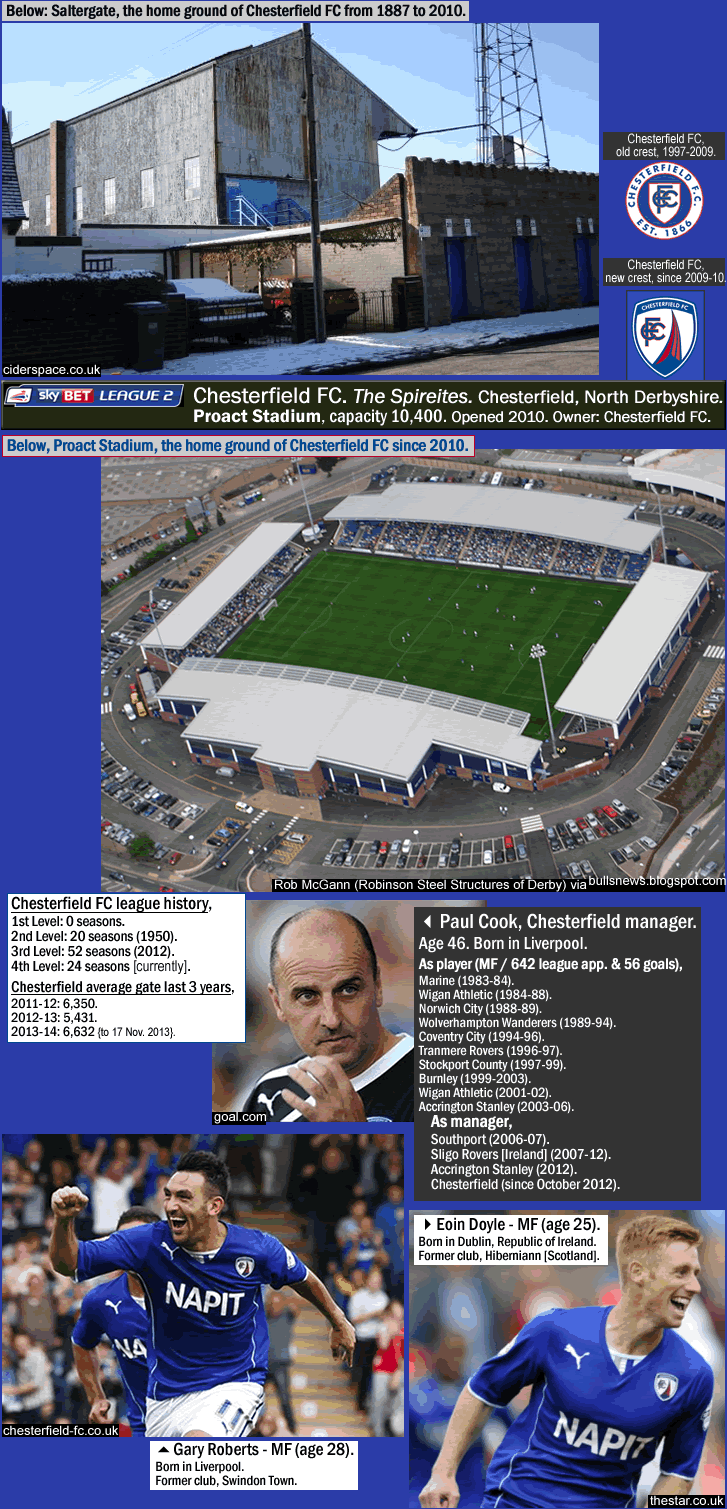
CFC’s old ground (Saltergate), photo from ciderspace.co.uk/asp/opposition/chesterfield.
Aerial photo of new stadium by Rob McGann (Robinson Steel Structures of Derby) via bullsnews.blogspot.com/2010/08/chesterfields-new-stadium.
Paul Cook, photo from goal.com.
Gary Roberts, photo from chesterfield-fc.co.uk/news/article/20131111-roberts-post-daventry.
Eoin Doyle, photo from thestar.co.uk
…
Rochdale AFC, currently 3rd place (29 points/+5 goal difference).
Rochdale AFC play at Spotland Stadium, in Rochdale (which is in the north-eastern part of Greater Manchester, but was historically in the south-eastern part of Lancashire). Rochdale borough has a population of around 95,000 {2001 census figure}. Spotland has a capacity of 10,249, was opened in 1920, and was last renovated in 1999-2000. Ownership of the ground is a three-way split between Rochdale Borough Council, Rochdale AFC, and the (just-promoted) second-division rugby league club Rochdale Hornets RLFC. Rochdale AFC, aka the Dale, draw 2.5 K or so in mediocre years and up to 3.5K in good seasons, and have done so for over two decades now {attendances from E-F-S site, here}.
Rochdale AFC manager Keith Hill (age 44), was born in Bolton, Lancashire. Hill was a defender who had 388 league appearances and 11 goals, playing for Blackburn Rovers, Plymouth Argyle, Rochdale (for 5 seasons), Cheltenham Town, Wrexham, and Morecambe from 1987 to 2003. Hill is now in his second spell managing Rochdale, after previously getting the club promoted to the 3rd division for the first time in 36 years (in May 2010, seen in photo below). Following that 4-and-half-year spell running Rochdale, Hill was hired by second division club Barnsley in June 2011, but was sacked in December 2012 as Barnsley languished in the relegation zone (Hill’s then-number-two, David Flitcroft [who was also assistant under Hill at Rochdale], took over, and did a fine job of keeping Barnsley in the Champiionship by the skin of their teeth last May).
Keith Hill returned to Rochdale in January 2013, with one objective – to get the Dale back to the third division. Rochdale currently feature twin scoring threats in the Norfolk-born ex-Colchester FW Ian Henderson (age 28), who has tallied 5 league goals this season so far; and a young potential phenom in the 21-year old striker Scott Hogan, who is Manchester-born and previously played for Conference side Hyde. Hogan has scored 6 league goals so far this season.
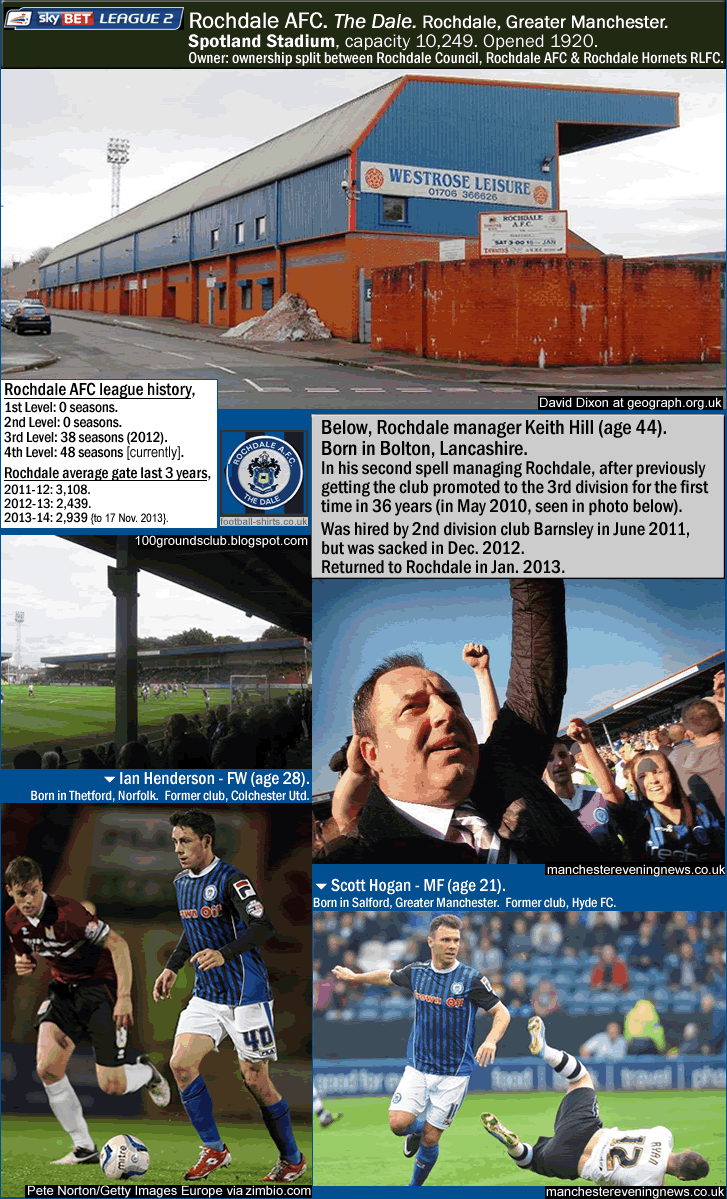
Photo and Image credits above -
Exterior-view of main stand at Spotland, photo by David Dixon at geograph.org.uk.
Photo of 13/14 RAFC home jersey badge from football-shirts.co.uk/rochdale-shirt.
Interior photo of Spotland by 100groundsclub.blogspot.com/2009/08/my-matchday-223-spotland
Keith Hill celebrating May 2010 Rochdale promotion (during pitch invasion), photo from manchestereveningnews.co.uk.
Ian Henderson, photo by Pete Norton/Getty Images Europe via zimbio.com.
Scott Hogan, photo from manchestereveningnews.co.uk.
…
Fleetwood Town, currently 4th place (28 points/+9 goal difference).
Fleetwood has a population of around 26,000 {2001 census figure}. Fleetwood is just north of Blackpool on the Fylde coast of west-central Lancashire.
Fleetwood Town manager Graham Alexander played 21 years for Scunthorpe United, Luton Town, Preston North End, and Burnley, as a defender and a holding midfielder. Alexander became the oldest player to make his Premier League debut at the age of 37 (when he played right back/defensive midfielder for Burnley in the 2008-09 Premier League). Alexander was also the third oldest goal scorer in Premier League history. A dead-ball specialist, he retired in 2012 with 837 league appearances and 107 league goals (130 goals in all competitions). In Graham Alexander’s final match in April 2012, he scored a 92nd-minute equalizer at Deepdale versus Charlton. Graham Alexander played well over one thousand games in all competitions, second-most as a pro in the English leagues only to Tony Ford {see this ‘Tony Ford (footballer born 1959)‘}.
Alexander made his coaching debut in December 2011 while still a player, as a joint-caretaker manager of Preston North End (along with David Unsworth), following Preston’s sacking of Phil Brown. That position only lasted 5 games, though, as Preston brought in tough guy Graham Westely, to poor results (Westley has slunk back to 3rd-division-but-relegation-threatened Stevenage now). Alexander was appointed manager of Fleetwood Town in December 2012, following the surprise sacking of Mickey Mellon. Mellon had gotten Fleetwood Town into the Football League in May 2012. Fleetwood Town is a former 9th- and 8th-division club which has won 5 promotions in the last decade. This is a club that was drawing just 206 per game nine seasons ago in 2004-05, and now draws in the vicinity of 2,800. Actually, at the time of his sacking last December, Mellon had the Cod Army in the play-off places (in 7th place). But Mellon’s squad had just lost 3 matches in a row including an FA Cup 2nd Round match to Aldershot. Graham Alexander didn’t exactly have too poor a run-in managing Fleetwood for the latter half of last season, but, for all intents and purposes, once the Fleetwood squad knew they were safe from relegation, they coasted, and Fleetwood finished in 13th place in 2012-13, losing their final 4 matches. In the off season there were a few key personnel moves. The headline-maker was the club’s biggest signing ever, of Jamaican-born almost-23-year-old FW Jamille Matt (bought from Kidderminster for an undisclosed sum above £200,000). There was also the signing of 21-year-old play-maker Antoni Sarcevic, a MF with real potential, who was instrumental in getting Phoenix-club Chester FC up into the Conference last season. Both have produced so far, with Matt scoring 5 league goals in 12 appearances and Sarcevic netting 3 times with 3 assists.
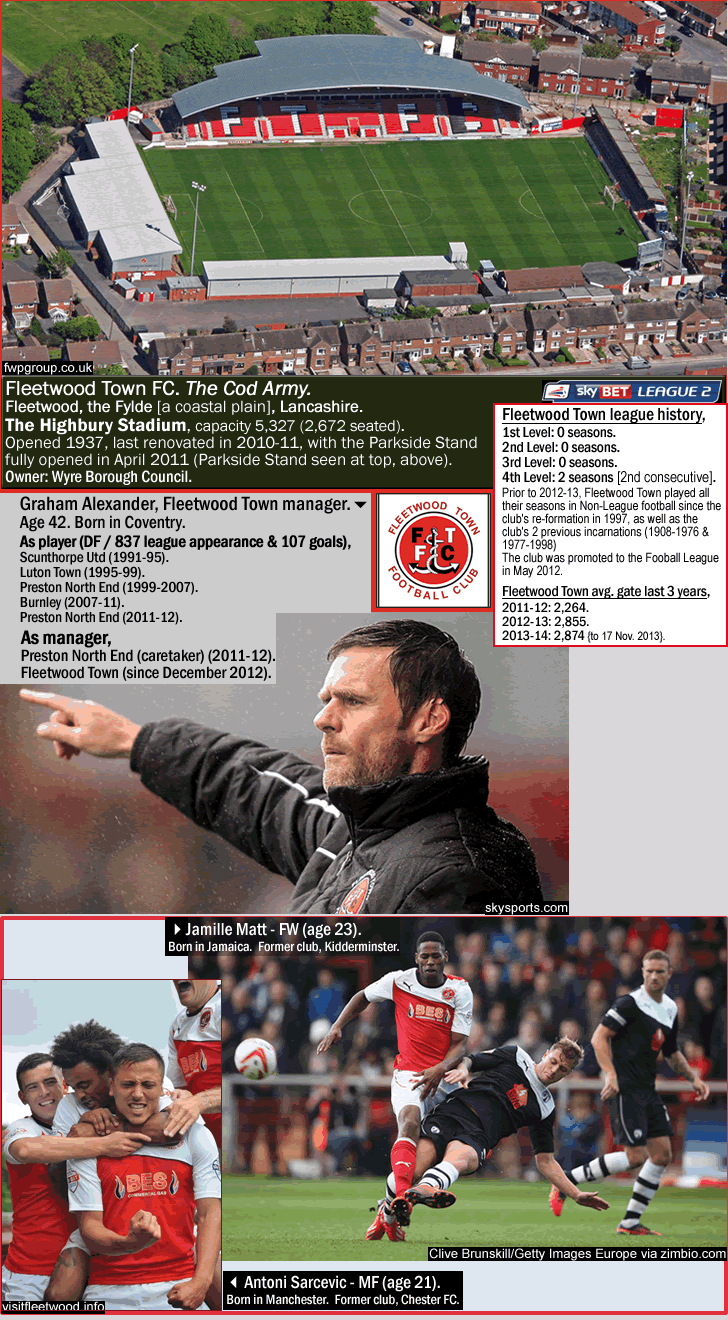
Photo and Image credits above -
Aerial photo of Highbury Stadium, from fwpgroup.co.uk/job/fleetwood-town-football-club.
Photo of Graham Alexander, from skysports.com.
Photo of Jamille Matt, by Clive Brunskill/Getty Images Europe via zimbio.com.
Photo of Antoni Sarcevic and Fleetwood teammates celebrating from visitfleetwood.info.
__
Thanks to footballfashion.org and Igloo Films, at footballfashion.org/wordpress/2013/07/29/portsmouth-fc-201314-sondico-home-and-away-kits/, for image of Portsmouth 13/14 home jersey badge.
Thanks to Football-shirts.co.uk for photo of Rochdale 13/14 home jersey badge, football-shirts.co.uk/rochdale-shirt.
Thanks to Torquay United shop for images which allowed me to assemble a 13/14 TUFC home jersey badge facsimilie {tufcshop.com/tufc-2013-coaster ; tufcshop.com/tufc-replica-kits }.
Thanks to the contributors at en.wikipedia.org, ‘2013–14 Football League Two‘.





